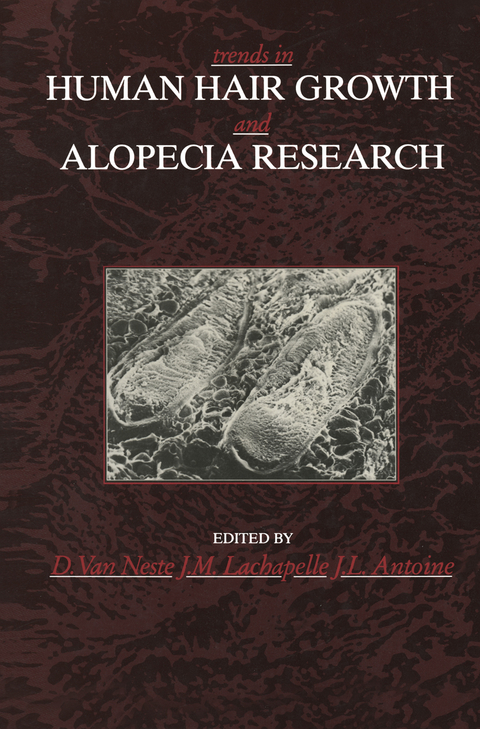
Trends in Human Hair Growth and Alopecia Research
Springer (Verlag)
978-94-011-7875-4 (ISBN)
Studying hair differentiation is, in fact, studying growth regulation and it is this aspect that by far transcends the importance of studying hair growth itself. Let us not forget that metastatic prostate cancer is treated with the same drug -cyproterone acetate -that is used for the treatment of alopecia and hirsutism in women.
I: Biology and Experimental Models.- 1 Embryogenesis of the hair follicle and hair cycle.- 2 Keratin expression in the human hair follicle.- 3 The mammalian tongue filiform papillae: a theoretical model for primitive hairs.- 4 Comparative electrophoretic analysis of sulfur containing proteins of hair bulb keratogenous zone and hair shaft.- 5 Four murine monoclonal antibodies specific for the inner root sheath in the human hair follicle.- 6 The dermo-epithelial interaction and the hair follicle.- 7 Isolation, culture and in vitro behavior of cells isolated from papillae of human hair follicles.- 8 A new in vitro culture system to produce a fully differentiated epidermis from human hair follicle outer root sheath cells.- 9 Non-keratinocyte cells in the hair follicle (with special emphasis to the human hair follicles).- 10 The human hair follicle: a target for androgens.- 11 Effects of testosterone, dihydrotestosterone and estradiol on the growth behavior of cultured hair bulb papilla cells and root sheath fibroblasts.- 12 Pharmacological aspects of hair follicle growth.- 13 Human hair follicle grafts onto nude mice: morphological study.- 14 On the behavior of dye ions in an isotachophoresis boundary: application to the mitosis mechanism.- II: Diagnostic Methods.- 15 Dynamic exploration of hair growth: critical review of methods available and of their usefulness in the clinical trial protocol.- 16 Phototrichogram analysis: technical aspects and problems in relation with automated quantitative evaluation of hair growth by computer-assisted image analysis.- 17 PIXE-microanalysis in green hair.- 18 Office diagnosis of pathological changes in hair cuticular cell pattern.- III: Hair and Scalp Diseases and Therapy: Trichothiodystrophy, Pattern Baldness, Alopecia Areata.- 19 Clinical symptoms associated with trichothiodystrophy: a review of the literature with special emphasis on light sensitivity and the association with xeroderma pigmentosum (complementation group D).- 20 High-sulfur protein deficient human hair: clinical aspects and biochemical study of two unreported cases of a variant type of trichothiodystrophy.- 21 The effect of cyproterone acetate on hair roots and hair shaft diameter in androgenetic alopecia in females.- 22 Androgenetic alopecia: some thoughts and views about its topical treatment.- 23 Effects of a topical preparation on some hair growth parameters evaluated utilizing morphometric computerized analysis.- 24 A placebo controlled clinical trial with a topical preparation containing HUCP and thioglycoran in male pattern baldness.- 25 Topical minoxidil used before and after hair transplantation surgery.- 26 Clinical and macrophotographic study of the percutaneous implantation of synthetic hair.- 27 Patch testing procedures in patients suffering from suspected allergic contact dermatitis to minoxidil.- 28 Histological study of alopecia areata.- 29 In situ immunophenotyping of follicular keratinocytes in alopecia areata.- 30 Expression of Langerhans cell antigens in the hair follicles in alopecia areata. Histological changes in alopecia areata.- 31 Analysis of T cell, activated T cell and NK cell subsets in peripheral blood lymphocytes from patients with alopecia areata.- 32 Mutagenic evaluation of SADBE in human lymphocytes.- 33 Treatment of severe alopecia areata by topical application of cyclosporine. Comparative trial versus placebo in 43 patients.- 34 Anatomo-clinical illustration of a hair-follicle naevus.- 35 Head gear induced traumatic alopecia during orthodontic treatment.
| Zusatzinfo | 336 p. |
|---|---|
| Verlagsort | Dordrecht |
| Sprache | englisch |
| Maße | 155 x 235 mm |
| Themenwelt | Medizin / Pharmazie ► Medizinische Fachgebiete ► Dermatologie |
| ISBN-10 | 94-011-7875-5 / 9401178755 |
| ISBN-13 | 978-94-011-7875-4 / 9789401178754 |
| Zustand | Neuware |
| Haben Sie eine Frage zum Produkt? |
aus dem Bereich


